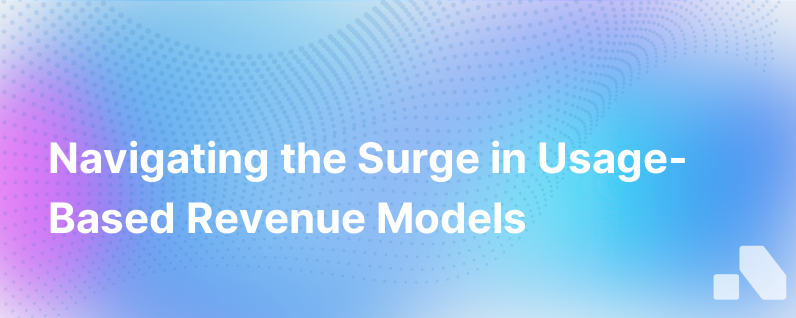
In the ever-evolving landscape of business, companies are continually seeking innovative ways to capture market share and drive growth. As we embrace the digital age with open arms, a seismic shift is occurring in the monetization strategy: the rise of usage-based revenue. This model stands to disrupt and transform the way companies operate and engage with their customers, ushering in a new era of flexibility, scalability, and customer-centricity.
Understanding Usage-Based Revenue
Usage-based revenue, also known as consumption-based or pay-as-you-go pricing, is a pricing strategy where customers are charged based on their consumption of goods or services rather than a flat fee. This model can be likened to a utility bill; the more you use, the more you pay. Within the B2B sector, this strategy has gained significant traction, particularly among SaaS (Software as a Service) and cloud services companies.
Factors Driving the Rise of Usage-Based Revenue
The shift towards usage-based revenue can be attributed to several interlinked factors, which include:
-
Technological Advancements: Advances in cloud computing, big data analytics, and machine learning have streamlined the process of tracking consumption, making usage-based billing more feasible and accurate.
-
Evolving Consumer Preferences: Modern customers demand value, transparency, and flexibility. Usage-based models appeal to these preferences, as they empower customers to pay for only what they need and use.
-
Competitive Pressure: As more businesses adopt this model, others follow suit to remain competitive, creating a domino effect across various industries.
-
Economic Benefits: This model can aid in customer acquisition and retention by lowering the barrier to entry and aligning costs with value perceived by the customer.
The Impact on Revenue Streams
Usage-based models are attractive for their potential to create more dynamic and resilient revenue streams. They encompass several advantages:
-
Scalability: The model aligns perfectly with companies looking to scale, as costs typically scale in tandem with usage, benefiting both customers and providers.
-
Customer Lifetime Value (CLV): It encourages increased usage over time, which can lead to greater revenue as the customer's business grows.
-
Predictable Revenue: While variable, consumption data can provide insights that lead to predictable and potentially more stable long-term revenue streams.
-
Customer Acquisition and Retention: Lower upfront costs can reduce churn and attract price-sensitive customers, creating more long-term, loyal customer bases.
Challenges and Considerations
With any seismic shift, there are headwinds to consider. An effective transition to usage-based revenue entails surpassing hurdles such as:
-
Complexity in Billing: Usage-based billing can be more complex to manage and requires sophisticated systems to track and bill accurately.
-
Revenue Recognition: Accounting for usage-based revenue can be challenging, and companies must ensure compliance with revenue recognition standards like ASC 606.
-
Customer Education: Customers must clearly understand how charges are calculated to avoid surprises and maintain trust.
-
Predictable Cash Flow: Unlike a subscription model with recurring and predictable payments, consumption-based models can lead to more unpredictable cash flows.
Best Practices for Implementing Usage-Based Revenue Models
Switching to a usage-based model or integrating it into an existing pricing strategy involves careful planning and execution. Some best practices include:
-
Deep Customer Insights: Understand how your customers use your product or service to create a pricing model that reflects the value they derive from it.
-
Transparency: Be upfront about how the billing works. Hidden fees or convoluted pricing can quickly erode trust.
-
Robust Billing Systems: Invest in or develop billing systems equipped to handle complex usage tracking and billing processes.
-
Flexibility: Offer various pricing tiers or hybrid models that cater to different customer needs and usage patterns.
-
Continuous Monitoring: Regularly analyze usage patterns and customer feedback to adapt and fine-tune your pricing model.
-
Educate Your Sales Team: Your sales force needs to understand the intricacies of this pricing model to effectively sell it.
Usage-Based Revenue in Action
Let's consider a real-world application. A cloud storage provider, CloudSave, used to charge a flat fee for storage space. However, they noticed that smaller companies were hesitant to commit due to perceived underutilization, while larger customers wanted more flexibility.
CloudSave switched to a usage-based model, charging per gigabyte stored. Small companies embraced the change due to the lowered initial cost, while larger customers appreciated the cost scaling with their growth. CloudSave experienced a 20% increase in customer acquisition and a 10% reduction in churn within the first year.
Conclusion
The rise of usage-based revenue is more than a trend; it's a transformative shift in the fundamental approach to business pricing models. This flexible, customer-centric strategy offers immense potential for enhancing customer satisfaction, increasing revenue potential, and maintaining competitive advantage.
While there are hurdles to overcome, the benefits are too compelling to ignore. If implemented thoughtfully, with robust systems in place and a commitment to transparency, usage-based pricing can catalyze the next wave of growth for forward-thinking companies.
In the digital era where accessibility, scalability, and personalization are the cornerstones of customer satisfaction, usage-based revenue models are not just the future; they are the present. Embracing this approach strategically can yield unparalleled benefits and set the stage for sustainable long-term growth.